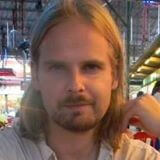|
Meghan O'Donnell is a lecturer of history at California State Monterey Bay. Her research revolves around nationalism and collective identity. She has written on religious nationalism, cultural assimilation, secularizing of politics, political aesthetics, social activism and violence. |
ALEXANDER CHIRILA, Webster University
Director, Library of Social Science’s YOUNG SCHOLARS INITIATIVE
Assistant Professor at Webster University, Thailand, Alexander Chirila heads up Library of Social Science’s YOUNG SCHOLARS INITIATIVE. “We are seeing a surge in new ways of presenting and assessing information,” Chirila says. Professor Chirila will be working with us—and with scholars around the world—to develop methods for disseminating significant research and writings to a wider audience. |
|
During the reign of the Third Reich, Adolf Hitler, along with his devoted followers, made plans for Germany founded on principles of superiority, a master race and the belief in “A Thousand-Year Reich.” German Kultur, art and monumental architecture represented the tools with which Hitler could raise Germany up from a nation suffocating from depression and despair, to one thriving with confidence and pride.
Yet beneath this façade of cultural glory and German supermen was the paradoxical obsession with death, ruin, and martyrdom. Inspired by Wagner, neo-Romanticism, monumentality, and volkish ideology, Hitler crafted a Germany built on sacrifice, hero worship, and fascist aesthetic politics. The culmination of which contributed to the creation of a Nazi Totenkult; a powerful civil religion that ultimately ended in an ideological national suicide and widespread immolation at the end of World War II.
Wagner’s work and his Bayreuth Music Festival had long been embroiled in the ideological “battle for the soul of Germany” between the conservative advocates of the Volk and the established Weimar cultural structure. But with the rise of Hitler and his neo-Romantic volkish nationalism came “an ideological rampage that translated Wagnerian opera into a national cultural religion with Bayreuth as its supreme place of worship.”
The obsession of Hitler and the true disciples of the Volk movement, with Wagner, elevated his work to an entirely irrational place of reverence within the new German Kultur of the Third Reich. His seminal operas of Der Ring des Nibelungen, and Tristan und Isolde, apart from highlighting the superiority of the Teutonic race, also magnified the dark and violent love affair with death and glorified ruin, which was featured so often in Romantic art and became an essential thematic element to Hitler’s Totenkult.
Wagner’s Der Ring des Nibelungen, or The Ring of Nibelung is actually a cycle of four operas, Das Rheingold, Die Walküre, Siegfried, and the final opera Die Gotterdammerung. The latter translates as “Twilight of the Gods” and was said to be Hitler’s favorite opera of all time. The hero Siegfried and his lover Brunhilde die heroes‟ deaths in an apocalyptic vision of the end of the world.
Before she is consumed by flames, Brunhilde cries out, “Laughing let us be destroyed; laughing let us perish...let night descend, the night of annihilation...laughing death...laughing death.” In the second act of Die Walküre, Brunhilde’s father, the god Woton cries, “I want only one thing yet, the end, the end.” Yet the appeal to glorified death did not end with Der Ring des Nibelungen.
In essence, death was a “central part of the ethos of the Third Reich.” However, Hitler did not rely on Wagner and a legacy of neo-Romanticism alone to construct his Totenkult; another fundamental element was the cult of dead heroes.
Hero worship and “The Cult of the Fallen Soldier,” represent the clearest and most affecting examples of the paradoxical nature of Hitler’s dream for Germany. Following World War I, most Germans had a clear understanding of sacrifice as realized through the blood of their young soldiers. This is especially true for the “Myth of Langemark,” an important battle for the ethnohistory and death iconography of World War I.
At Langemark, Belgium on 26th of October 1914, hundreds of young German soldiers marched into no man’s land to their death. As the myth goes, the boys marched all the while singing “Deutschland, Deutschland über Alles, über Alles in der Welt,” the opening verse of The Song of Germany or Das Deutschlandlied.
Thousands of young men were slaughtered, but the myths surrounding their death became an essential part of death cult ideology. Emil Alefeld, a soldier present that night, had written a letter to his family beforehand in which he recounted:
We are Germans; we fight for our people and shed our blood and hope that the survivors are worthy of our sacrifice. For me this is a struggle for an idea, the Fata Morgana of a pure, loyal, honorable Germany. And if we go to our deaths with this hope in our hearts, perhaps it is better than to have the victory.
The attitude expressed by this naïve German soldier speaks to the glorified ideal felt by many Germans that “Death in battle not only guaranteed eternal life for the martyr but also acted as a resurgent life force for the Fatherland.” The last line in his letter, “perhaps it is better than to have the victory” also shows the notion that sometimes the sacrifice is more important than the actual victory itself.
|

